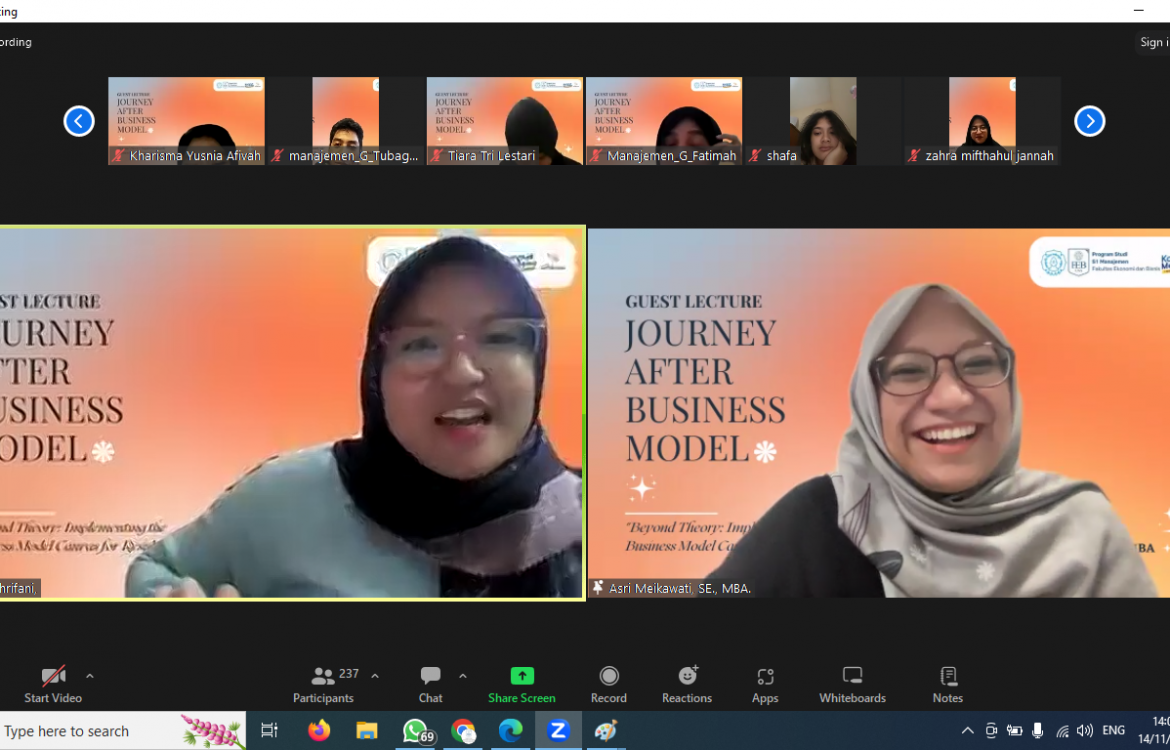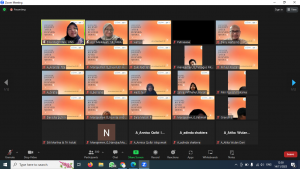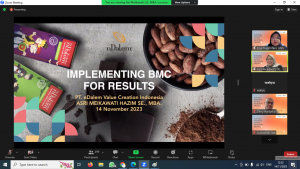
Undergraduate Study Program Management Guest Lecture Discussing Implementing the Business Model Canvas for Result
The Business Model Canvas describes how an organization builds, delivers, and captures value. The Business Model Canvas consists of nine main blocks that represent the core elements of a business, customer segments, value proposition, channels, customer relationships, revenue streams, key resources, key activities, key partnerships, and cost structures.
The Business Model Canvas may change over time due to certain developments in the business condition. For example, during the Covid-19 pandemic, many channels changed, the customer relationships also changed. Although the value proposition has not changed, the way it is conveyed has transformed. Moreover, the most affected aspect after the pandemic ended was the customer segment.
This statement was conveyed by Asri Meikawati Hazim, S.E., MBA., CEO of PT. nDalem Value Creation Indonesia at the Guest Lecture hosted virtually by the Management Study Program, Faculty of Economics and Business (FEB), Universitas Sebelas Maret (UNS), Tuesday, November 14, 2023.
Furthermore, Asri explained to approximately 300 participants that in planning a business there are 7 pillars, the first is from the business side, the second from the product side, the third is legality, the fourth is the team, the fifth is marketing, the sixth is distribution, and the last is collaboration.
From the business side, it is necessary to build a strong foundation for the business structure, thus it can be useful to support the business growth and development.
“The first foundation, which all of you have actually gone through, is to make a canvas model, but the business structure needs to be given a foundation, or what we call a justification or objective. The justification for making the business must be very strong, for example, the reason I made the business for the first time is simple, because I want to have income for my new family,” she said.
 In business development, the justification and objective can change. Even so, the important thing is that we are not lacking new objectives and consistency in maintaining business. Because sometimes many are discouraged in the middle of the way. We also have to learn more about the business we are in.
In business development, the justification and objective can change. Even so, the important thing is that we are not lacking new objectives and consistency in maintaining business. Because sometimes many are discouraged in the middle of the way. We also have to learn more about the business we are in.
The second foundation is market size, which calculates the market correctly. Market size is the total number of potential consumers or buyers in a particular market, and is an important aspect in determining business and market projections.
“To see the market size, you can just look at the internet, all the data is circulating in cyberspace, and we can know exactly who we want to sell to. Everything can be accessed on the internet. So friends, there is no reason for wondering how to get the data,” she said.
The next business foundation is to look at the advantages of our products by looking at competitor analysis. “We need to look at other brands, what strength they have, what are their advantages, thus, when we later want to tell about our products, we really have a very strong business foundation. Look at their social media, and buy competitor’s products. Know the value proposition that will be proposed on the model canvas. Then we can implement this value by looking at competitor analysis, thus, the value proposition we build can actually become a valid one,” she explained further.
In terms of products, the products we develop must have an attractive strength and uniqueness for consumers who become the business target market. Because the business cannot make everyone happy. It must be specifically selected, which part of the market will be the target market of the product. Meanwhile, if someone from a market sector beyond our target, buys a product, it is actually a bonus.
Asri also provides tips to participants who are about to establish a brand, she suggests they visit the intellectual property website pdki-indonesia.dgip.go.id to check for brands that have been registered as intellectual property rights. Because after all, the legal protection both in Indonesia and internationally applies to the party that has registered the trademark first. Those who registered a brand first get an intellectual property certificate or a brand certificate.
Furthermore, a newly established business needs to complete licensing as a provision in increasing the success potential in entering the market, legal documents include Business Entities (if needed, NIB, IUMK, NPWP), food distribution permits (PIRT, MD, Halal certification), intellectual property, and Co-branding.
The fourth pillar is team building, where we need to work together with the team for business operations and must invest time to provide personal training. To build a business team there needs to be Hackers, Hipsters, and Hustlers. Hackers are people who create products, technologists. Hipster is a design expert who finds a way to convey the message, thus, visual branding can reach wider consumers and be relevant to consumers, and Hustler is an expert in financial management.
On this occasion, Dila Maghrifani, SE., B.Sc., M.Sc., FEB UNS Lecturer, served as the moderator for the event, the Implementing the Business Model Canvas for Result, where participants had the opportunity to have a discussion with the speaker after the material presentation.

